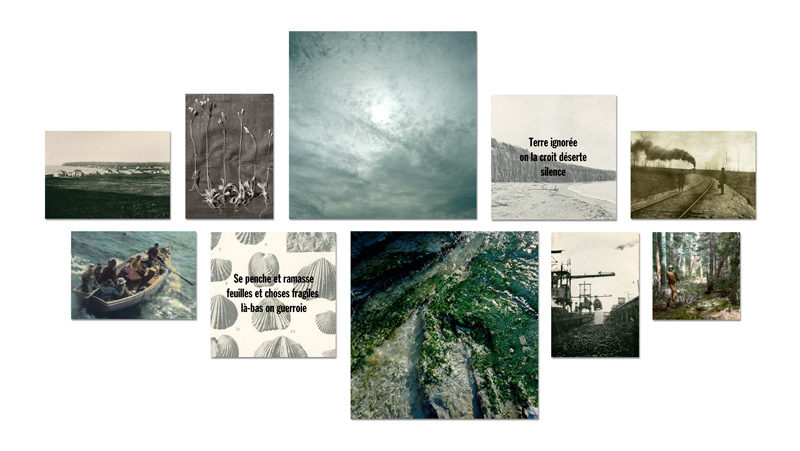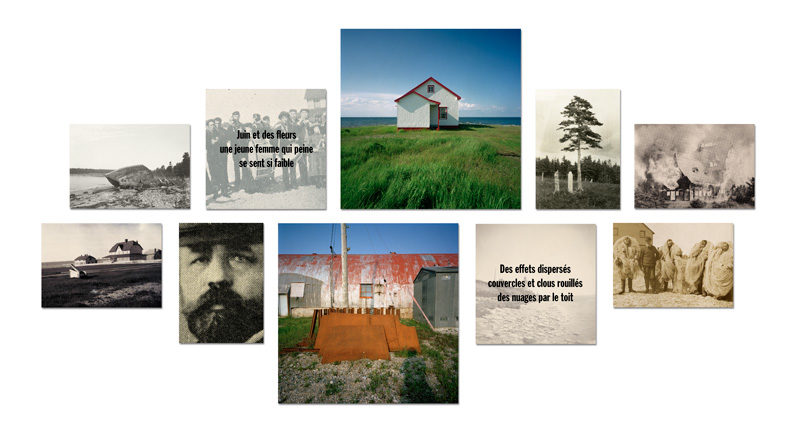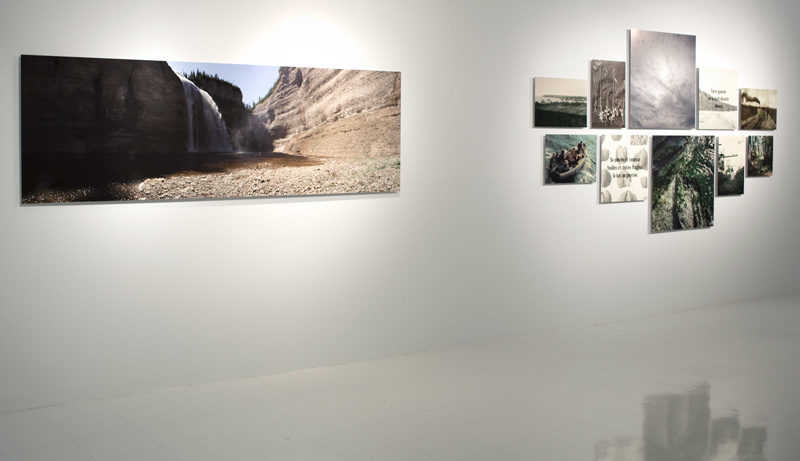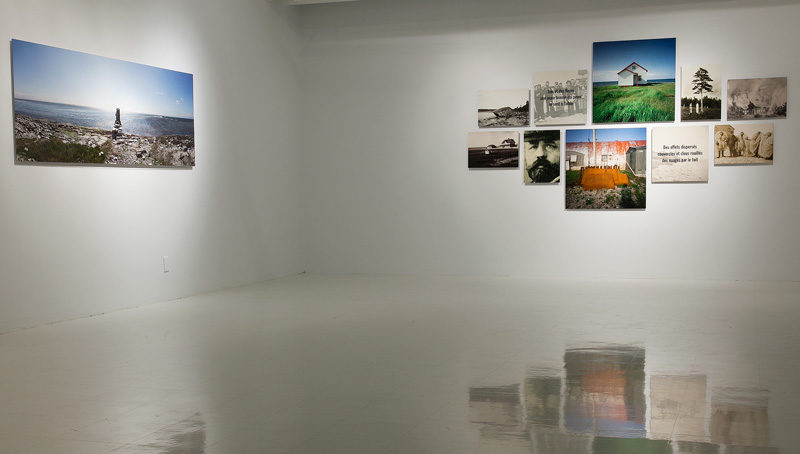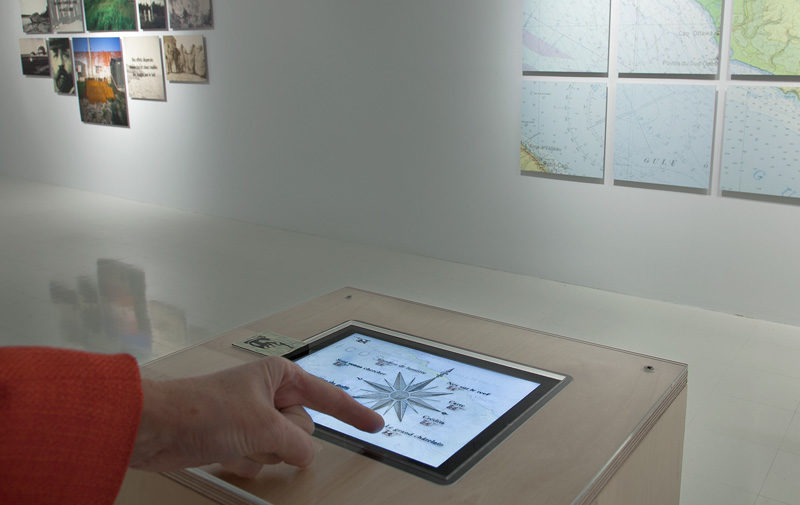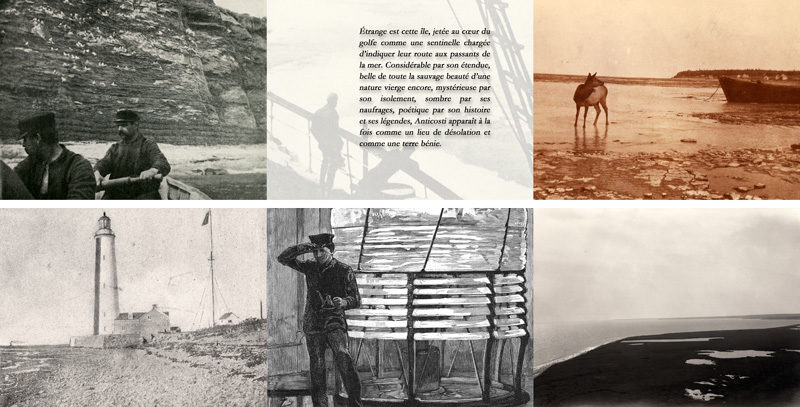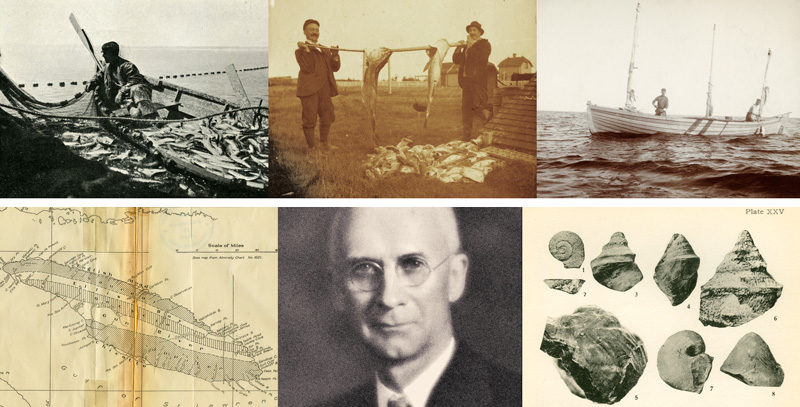[Spring-Summer 2013]
By Pierre Dessureault
Richard Baillargeon’s Anticoste is presented as a complex composition of heterogeneous materials organized in groups to create vast networks of significances, echoes, and resonances and to constitute a reflection both on the history of Anticosti and on the narrative processes implemented in knowledge and the relationship with the past. The artwork includes three mosaics of various documents and one of objects; three panoramic views; a large map of the island; and an interactive digital tablet that serves as a compass rose to orient viewers within this vast composition.
The large, asymmetrically shaped mosaics face photographs taken by Baillargeon during two stays on the island, in 2004 and 2011, as well as archival images, illustrations from folk tradition, texts written by the artist, excerpts of newspaper articles, travellers’ accounts, and pictograms. Like the objects found on the island and diverted from their utilitarian function by their inclusion in the installation space, all of these fragments produced by history become artefacts of the culture from which they emerged, which must be seen “as a concretion of skills, customs, ideas, and beliefs, no doubt engendered by individuals but always outlasting them.”1 Three panoramic views portraying the emblematic sites of the island are inserted between the mosaics and punctuate the exhibition. In their elongated space, the panoramas contribute the domain of nature, which reclaims its position in the field once occupied by culture, as evidenced by the vestiges of human occupation that barely emerge from the boreal vegetation. A large map of the island composed of fragments plucked from various eras is presented in the form of a grid.
The last component, the digital tablet that visitors may engage with and use, reprises much of the material presented and adds a large number of other documents organized in a series of six stories, each topped by a title that refers to a historical comprehension of the island. As the geographer Louis-Edmond Hamelin notes, “The long isolation of the island, by discouraging rapid circulation of accurate information, made it a very fertile territory for the culture of local stories. Anticosti being a ‘beyond,’ it could naturally be interpreted as a cemetery, an enigma, a foreign island, but also – why not – a paradise.”2
The last component, the digital tablet that visitors may engage with and use, reprises much of the material presented and adds a large number of other documents organized in a series of six stories, each topped by a title that refers to a historical comprehension of the island.
The story called Telle une grande baleine tells about the explorations that named the island and described it as a territory to be conquered, as a rich territory to exploit, or as a discovery to be appended to the known world. Jacques Cartier’s descriptions during his 1534 voyage and the maps made by Louis Jolliet, first seigneur of the island, portray it as a mythic country – a vision that was perpetuated until the turn of the twentieth century.
Le grand châtelain concentrates on the period from 1896 to 1926, when, under the governance of French industrialist Henri L. Menier, Anticosti saw unprecedented development of its natural resources and the creation of infrastructure works that made the closed and isolated island into an idealized society in phase with the progressivist concepts of the time. Arthur Buies, who visited Anticosti in August 1899, praised the determination of the five hundred individuals who “are forming the embryo of the future grandeur of this settlement that has no precedent in our history, which will one day bring forth from the depths of the forests and unfold, as they soar, the great wings of civilization.”3
The treacherous coastal waters of Anticosti were long seen as a threat to ships and their crews, and the losses of lives and goods earned the island the nickname “Cemetery of the Gulf.” An account of survival and loss, against the backdrop of humans’ eternal struggle against the elements, evokes the many maritime disasters that took place between 1829 and 1902, makes use of the testimonials of survivors and lighthouse keepers, notably one by Placide Vigneau, the self-appointed chronicler of the island’s local history from 1861 to 1924.
In counterpoint to the series of mythical, lyric, and utopian discourses, sont venus chercher… cites the scholarly accounts that view the island through the lens of natural history and science. A vast body of knowledge exists, as evidenced by studies throughout the nineteenth and twentieth centuries, that includes botanical studies and photographs by Brother Marie-Victorin and Jacques Rousseau, along with the writings of hydrographers, geologists, surveyors, and geometers who succeeded each other from 1926, when the paper manufacturers began their reign on the island, to 1974, when Anticosti was acquired by the government of Quebec.
Gardien de lumière is about lighthouses and their keepers, who were the first and, for many years, only permanent population of Anticosti. These outposts made it possible for navigators to safely approach the island. J. U. Gregory, head of the Quebec department of marine and fisheries, described in his book, published in 1886, the ingenious system instituted to save people who were shipwrecked: “Wherever one looks one sees planks with a hand painted on them, the finger pointing the direction one must follow and indicating, at each step, the distance to go to find the closest provisions depot or shelter.”4
Nés sur le reef describes the daily life of the island’s residents, the trades that they practised, and their social life. Jules Despecher reports that inhabitants of Anticosti “are all, with one single exception, simple tenants paying, as rent, a head tax per family, the objective of which is to conserve the island’s character as private property.”5 In the 1901 census, Anticosti was shown to have seventy-eight families and a total population of four hundred and twenty-nine. At the peak of development, there were up to eight hundred permanent residents.
Thus, the vast historical fresco painted by Anticoste is composed of a coexisting plurality of discourses displayed on the wall of the gallery and in the combinative digital tablet. Although each of these offerings brings together a great wealth of documents, none of them, taken individually, has meaning on its own. It is because they are juxtaposed to and confront each other through the montage that we are able to sort through this magma of undifferentiated signs, create an order that links them to each other, and “build great structures from very small elements fashioned carefully and tidily.”6 Through this displacement in time and space of the angle from which we view the traces of constructed history borne by personal and community memory, each fragment is inscribed in a new context that breaks with its original referents to become a dynamic element in an unprecedented network of discontinuous signs that is built before our eyes.
This treatment of visual and textual documents supported by photographic images creates a contrast that highlights their materiality. The renderings, textures, and diversity of formats – the screen visible in printed materials magnified by enlargement and reframing – remind us that they are material – paper, chemicals, optics, printing procedure. And like the objects presented, they bear the imprint of a history that is theirs alone. In reproducing them as is, without resorting to the numerous restoration methods that would erase the imperfections and bring them into conformity with today’s tastes, Baillargeon builds a jerky, non-linear path that provides a temporal depth for this history, which becomes superimpositions of meaning in infinitely recomposable groupings of traces left by events, humans, and cultures.
Thus, “It’s not that what is past casts its light on what is present, or what is present its light on what is past; rather, image is that wherein what has been comes together in a flash with the now to form a constellation.”7 The point is no longer, in this new, exploded configuration, to engage with the literality of the images attached to the actuality of their production, but to experience their actualization in the “now of a particular recognizability.”8 The past is not recomposed – organized and structured in the light of the present – to bring out a hypothetical hidden meaning that would emerge as if by magic from the confrontation of its debris, but as a memory brought to consciousness and returned to circulation in a series of discursive proposals that are spaces of remembering.
In this way, a permanent interpretive dialogue is constituted between the present of the images and the past that they represent. At the beginning of their path in the visual world, the images transmit not solely the reality of things and events but also their experience through a creator who, in framing and fragmenting the visible, imprints upon it the cultural landscape that shapes his gaze. What is more, the viewer’s gaze no longer alights on the actuality that the images re-present but on the experience provoked by their actualization in a discourse that returns them to the present by confirming their imaginary reality, which is substituted for the state of things that they depict. “I remember that January in Tokyo, or, rather, I remember the images I filmed that January in Tokyo. They have substituted themselves for my memory; they are my memory. I wonder how people who don’t film, who don’t photograph, who don’t record, remember, what humanity used to do to remember . . .”9
Translated by Käthe Roth
2 Louis-Edmond Hamelin “Mythes d’Anticosti,” Recherches sociographiques, vol. 23, no. 1–2 (1982), 140 (our translation).
3 Arthur Buies, Le Soleil [Quebec City], 23 September 1899, 1–2
(our translation).
4 J. U. Gregory, En racontant – Récits de voyages en Floride, au Labrador et sur le fleuve Saint-Laurent (Quebec City, 1886), pp. 162–63 (our translation).
5 Jules Despecher, Notice sur l’île d’Anticosti (Quebec City, 1895) (our translation), www.comettant.com/bibliothèque/despecher-anticosti/
6 Walter Benjamin, Paris capitale du XXe siècle – Le livre des passages (Paris: Les éditions du Cerf, 1989), p. 477 (our translation).
7 Walter Benjamin, The Arcades Project, trans. Howard Eiland and Kevin McLaughlin (Cambridge: Harvard University Press, 1999), p. 463.
8 Ibid.
9 Chris Marker, commentary in his film Sans soleil, 1983, DVD Criterion Collection, no. 387 (our translation).
Pierre Dessureault is a historian and of photography and independent curator. He has organized numerous exhibitions and published a large number of catalogues and articles on contemporary photography. He was the editor of Nordicité (Éditions J’ai VU, 2010), a book that brought together photographs by Quebec, Canadian, and Northern European artists and essays by experts in art history and the human sciences.


